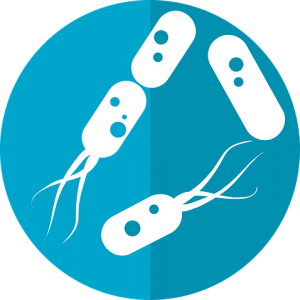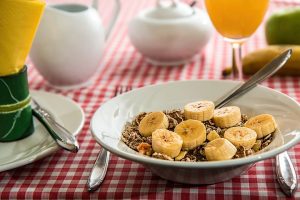Think your diet is pretty healthy? If you’re eating the USRDA recommended daily amounts of the various food groups, then there’s a good chance you are eating healthy. However, if you aren’t making the right choices when it comes to some of the foods you eat, specifically in the fruits, vegetables, and grains categories, you probably aren’t eating as good as you think. The fact is, studies have shown that only about 5 percent of adult Americans get enough fiber in their daily diet. Because many foods contain fiber, you can’t exactly call it a super-food, but it is a super-charged nutrient that’s essential for health. Read on to find out why you need more of it in your diet and how to increase daily fiber intake to make your body healthier and even help with weight loss.
Benefits of Fiber

Sufficient fiber in your diet keeps the bacteria in your gut healthy–and that helps keep you healthy and trim.
So, here’s the odd thing about fiber: you can’t digest it, so your body doesn’t absorb nutrition from it. “Why should I eat something I can’t digest?” you may ask. Because your body can process it into something useful that has important health benefits. Fiber used to be categorized as either soluble or insoluble, but researchers have found that there are different sub-types including viscous and fermentable fiber, both of which your body is capable of processing. Those types of fiber get broken down in your system and can serve as food for the bacteria in your gut. If you don’t eat enough fiber, the “microbiome” in your intestines becomes imbalanced. The bacteria can begin eating away at the mucous lining of your stomach resulting in stomach and digestive problems and, eventually, immune reactions.
Remember, though, that a variety of different types of fiber is necessary for health, including the insoluble type. Even though your body can’t digest or process it at all, it’s still useful because it keeps your digestive tract clean. As it moves through your intestines, it activates movement of everything else, so nothing remains behind to keep your system from working properly.
If those benefits sound a little too vague to get you excited about dietary fiber, the Mayo Clinic points out that the fiber in oats, beans, and flaxseed helps lower cholesterol and can assist in keeping your heart healthy by also lowering blood pressure and reducing inflammation. Soluble fiber also helps control blood sugar, making it useful for people with Type 2 Diabetes and even helping reduce the risk of developing the disease altogether. Plus, the Institute of Cancer Research reveals that fiber-filled fruits and vegetables can protect against various cancers such as:
- colon
- esophagus
- larynx
- mouth
- pharynx
- rectum
- stomach
The Weight Loss Factor
You may have heard that fiber can help with weight loss, but maybe you don’t understand how it works. Fiber tends to be low in calories, but it’s bulky, so it makes you feel full faster than less substantial foods do. Your body has to work at processing it—remember, some of it can’t even be processed!—so, you burn more calories when you eat fiber and it increases the amount of time your stomach takes to empty out. That means not only do you feel fuller after eating fiber, but you’ll feel fuller longer, so you won’t be tempted to snack between meals that include healthy amounts of fiber.
That explanation can sound like smoke and mirrors, but there’s more to fiber’s weight loss factor than trickery. One very specific type of fiber—glucomannan—has been shown to be exceptionally effective in reducing how much protein and fat your body absorbs. Plus, going back to those friendly little bacteria in your gut, studies have shown a link between obesity and decreased stomach bacteria, also finding that increasing dietary fiber to improve the microbiome in the intestines decreases obesity and risk factors for metabolic syndrome. Of course, you’ll get the best weight loss results if you not only increase your fiber intake but also shift gears on your overall diet to eat healthier along with increasing your physical activity, too.
Upping Your Fiber Intake

Mixing and matching fiber-filled foods is a delicious way to get more of the super-charged nutrient into your diet.
Yep, getting more fiber in your diet works to ward off horrific diseases and helps keep your weight down. So, how much do you need, and how can you make sure to get more of it each day? Basically, an adult should eat around 30 grams of fiber daily. While some people would like to think that’s as simple as taking a fiber supplement like Metamucil and not worrying about the fiber/diet/exercise factors, unfortunately, it’s not that easy. You may see some minimal results from supplements like those, but it’s better if you get a variety of different types of fiber from a variety of foods. The good news is, there are loads of delicious things you can snack on and use to prepare meals that contain fiber. Healthline lists over 20 of them, including:
- pears
- avocados
- bananas
- pears
- pumpkin
- beets
- artichokes
- legumes like lentils, garbanzo beans, split peas, and kidney beans
- quinoa
- whole grains
- nuts and seeds such as almonds, walnuts, sunflower seeds, and Chia seeds
- sweet potatoes
Each food delivers a different amount of fiber, but it all adds up. The good news is that some of the tastiest nibbles contain the most fiber, such as oats (10.6 grams of fiber per 100 grams of raw oats), popcorn (14.5 grams of fiber per 100 grams of air-popped corn), and dark chocolate (10.9 grams of fiber per 100 grams of chocolate).
Get creative when thinking of ways to eat more fiber. Combine food and fiber types, like topping a banana yogurt smoothie with whole grain granola and nuts. Cook up a delicious pot of seven bean soup. Or, go gourmet with a savory plate of pasta smothered in a delectable fiber-packed sauce. There are so many options, you might forget you’re actually eating healthier.

